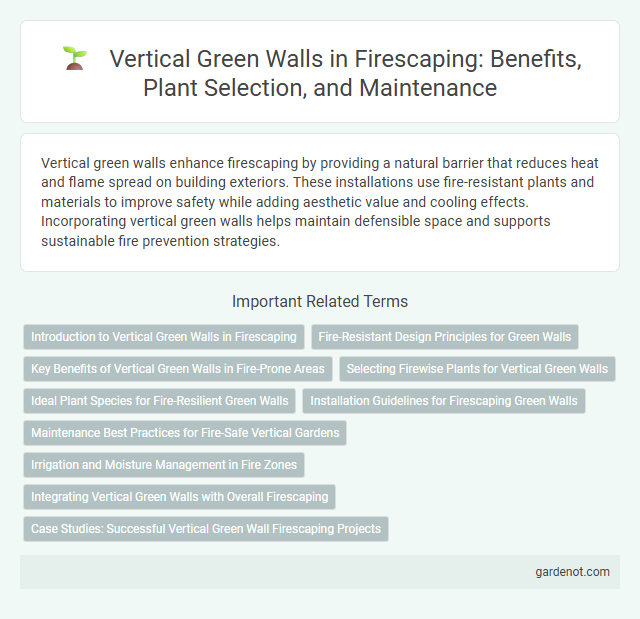Vertical green walls enhance firescaping by providing a natural barrier that reduces heat and flame spread on building exteriors. These installations use fire-resistant plants and materials to improve safety while adding aesthetic value and cooling effects. Incorporating vertical green walls helps maintain defensible space and supports sustainable fire prevention strategies.
Introduction to Vertical Green Walls in Firescaping
Vertical green walls function as living barriers that enhance firescaping by reducing heat radiation and slowing fire spread through layers of moisture-rich foliage. These walls incorporate fire-resistant plant species and engineered substrates designed to retain water, creating a natural buffer against flames. Integrating vertical green walls into firescaping plans improves property protection while promoting sustainable landscaping practices.
Fire-Resistant Design Principles for Green Walls
Vertical green walls designed with fire-resistant principles incorporate non-combustible or fire-retardant materials such as metal frameworks and fire-resistant insulation to minimize fire spread. Selection of drought-tolerant, low-flammability plant species like succulents and certain ferns reduces fuel load and enhances safety. Integrating adequate spacing between plant clusters and maintaining regular irrigation systems further mitigate ignition risks and enhance overall fire resilience.
Key Benefits of Vertical Green Walls in Fire-Prone Areas
Vertical green walls significantly enhance fire resistance by incorporating fire-retardant plants and moisture-retaining substrates, reducing heat intensity and flame spread on architectural surfaces. These living walls improve air quality and biodiversity while providing natural insulation that lowers building temperatures and energy consumption during wildfires. Their strategic use in fire-prone areas creates defensible space, mitigates ember attack risks, and strengthens overall landscape resilience against extreme fire events.
Selecting Firewise Plants for Vertical Green Walls
Choosing fire-resistant plants for vertical green walls is crucial to minimize fire hazards while maintaining lush aesthetics. Opt for species like succulents, aloe vera, and sedum, which have low flammability due to high moisture content and minimal resin. Implementing firewise plants with proper irrigation and strategic spacing enhances safety and resilience in fire-prone areas.
Ideal Plant Species for Fire-Resilient Green Walls
Ideal plant species for fire-resilient vertical green walls include succulents like Sedum and Agave, due to their high moisture content and low flammability. Native grasses such as Muhlenbergia rigens and drought-tolerant shrubs like Artemisia californica offer natural fire resistance while promoting biodiversity. Choosing these species enhances the vertical garden's ability to withstand wildfires and reduces fire spread risks effectively.
Installation Guidelines for Firescaping Green Walls
Installation of vertical green walls for firescaping demands fire-resistant plant species and non-combustible structural materials such as treated metal frames and cementitious backboards. Ensure adequate spacing between the wall and the building to promote airflow and reduce heat transfer during a fire event. Incorporate drip irrigation systems and maintain regular pruning to minimize the accumulation of dry vegetation, which could act as fuel.
Maintenance Best Practices for Fire-Safe Vertical Gardens
Regular inspection and pruning of vertical green walls are essential to prevent the accumulation of dry, flammable materials that pose fire hazards. Utilizing fire-resistant plant species such as succulents and maintaining adequate moisture levels reduce ignition risks in urban firescaping. Implementing irrigation systems and ensuring proper spacing enhance airflow, which is crucial for minimizing fire spread in vertical garden installations.
Irrigation and Moisture Management in Fire Zones
Vertical green walls in fire zones demand specialized irrigation systems designed to maintain consistent moisture levels while minimizing water waste. Drip irrigation combined with moisture sensors allows precise control, reducing dry periods that increase fire risk. Proper moisture management improves plant resilience, creating a living barrier that diminishes flame spread and heat intensity near structures.
Integrating Vertical Green Walls with Overall Firescaping
Integrating vertical green walls into firescaping enhances fire resistance by selecting fire-retardant plant species and incorporating non-flammable structural materials. These living walls act as natural barriers, reducing heat radiation and slowing fire spread around buildings. Combining green walls with defensible space strategies improves overall landscape resilience and safety against wildfires.
Case Studies: Successful Vertical Green Wall Firescaping Projects
Case studies of successful vertical green wall firescaping projects demonstrate enhanced fire resistance and reduced heat exposure through strategic plant selection and wall design. Projects like Melbourne's urban fire-safe facades and California's wildfire-prone community green walls show significant effectiveness in limiting flame spread and improving structural resilience. These case studies highlight the integration of fire-retardant vegetation and advanced irrigation systems as key factors in vertical green wall fire mitigation strategies.
Vertical green wall Infographic

 gardenot.com
gardenot.com